Steven Sandor's Blog, page 104
March 16, 2015
Catching up: Canada’s U-17 loss, Week 2 of the Quintessentially Canadian Power Rankings

Steven Vitoria
The last few days have been a whirlwind; and it’s meant I’ve had to a take the last 72 hours away from soccer.Getting the fifth issue of Plastic Pitch to release required a massive push last week; as well, I have until the end of the month to finish the final draft of my latest novel for young adults. And, I am writing this post from an Austin, Tex. hotel room; last night, I attended the premiere of Malcolm Ingram’s new documentary, Out to Win, at the SXSW Film Festival.
(Full disclosure: I’m a partner in OTW’s production company.)
I got the chance to meet some incredible athletes, both Canadian and American, who have come out; and, the film is a reminder — to paraphrase Outsports’ Cyd Zeigler — of the power sport has when it comes to social change. It was my pleasure to be in the company of Dave Kopay, the NFL player who, in the early ‘70s, was the first “out” athlete; Canadian women’s hockey goalkeeper Charline Labonte and her partner, Canadian speed skater Anastasia Bucsis; retired NBA centre Jason Collins and Wade Davis, former NFLer and the director of You Can Play.
And, well, when in Austin, let’s just say the whole town carries a mesquite smoke smell. So, yes, the barbecue is fantastic.
But, I did want to take the chance to catch up on a couple of things: The elimination of Canada’s U-17s from the U-17 World Cup picture and the second instalment of The 11’s Quintessentially Canadian Power Rankings. (For more on the methodology, click here).
As I mentioned last week, the rankings are allowing for Steven Vitoria, who played as a youth for Portugal but has made rumblings about playing for Canada, and Tesho Akindele, who turned down a Canadian national-team invite, went to a U.S. camp, but claims to have not made a final decision. Ethan Finlay is not counted because, while he’s been courted by Canada, the Columbus Crew striker has yet to make any sort of commitment — and he was born in America.
So, through two weeks, here we go. First, the players: Total minutes played, total appearances in brackets:
PLAYER RANKINGS:?
1. Steven Vitoria, PHI 180 (2)
2. Tesho Akindele, FCD 166 (2)
3. Russell Teibert, VAN 154 (2)?
4. Jonathan Osorio, TFC 135 (2)?
T5.Sam Adekugbe, VAN 90 (1)
T5.Marcel de Jong, SKC 90 (1)
7. Ashtone Morgan, TFC 45 (1)
CORRECTION: 8. Kyle Bekker, FCD 1 (1)
TEAM RANKINGS:
Vancouver 244
Philadelphia 180
Toronto FC 180
FC Dallas 167 (CORRECTED)
Sporting Kansas City 90
Now, back to the U-17s, who lost 2-0 to Costa Rica Sunday in their do-or-die playoff game at the CONCACAF Championships. Canada failed in its attempt to qualify for the U-17 World Cup.
Canada would have qualified automatically as the winners of its pool had it been able to beat Panama in its final group-stage game. But, the Canadians lost to Panama, and weren’t able to take advantage of the fact that Mexico could only manage a draw in its final group-stage match, opening the door for our kids to win Group B and get an automatic U17WC berth.
Canada beat Costa Rica 3-2 in the group stage but, when the spot was on the line in the playoff, the Canadian scoring touch disappeared.
Said Canadian coach Sean Fleming: “I’m very disappointed, obviously. It’s more the goals we gave up that were easily avoidable. I give great credit it our kids, though. I’m so proud of them. They stayed to the task for the whole 90 minutes and it’s football. We created good chances today. We had a good game plan. There was nothing that surprised us. It was just a bit of lack of execution at the key moments. I’ve been in these games enough now that if you do that, you’ll unfortunately get the wrong result. So it’s very disappointing.
“It’s a great learning moment for our kids and for our program. But we created chances, which I was happy about. But why didn’t we finish—it’s one of those things. We had several chances to shoot in the first half that for whatever reason, we started passing instead of shooting the ball.”
But, let’s remember that we should look at our U-17s a little differently than our senior players or even our U-20s. These are all academy players, prospects who aren’t yet getting paid to play the game. And that means, without sounding too much like high-school newspaper journalism (“they all tried really hard!”), that we should be looking at our system and not the kids themselves. It’s a disappointing result, but in no way should we pile on to kids or have the same expectation of 16-year-olds as we do of senior professionals.
March 13, 2015
Miller on FCE’s probable season-opening starting XI: “One or two spots up for grabs”
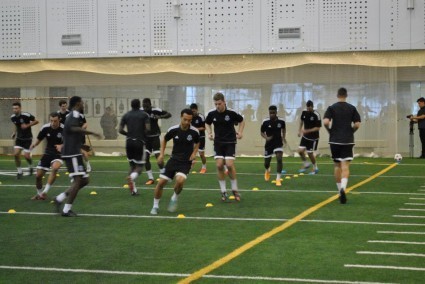
FC Edmonton’s indoor training session have come to a close.
FC Edmonton’s players have gone through 16 indoor sessions at the Commonwealth Fieldhouse over the last three weeks. Now, they’re ready to hit the great outdoors for the final three weeks of their NASL preseason camp.The team finished their Edmonton part of training camp with a 70-minute scrimmage, and will depart for Florida over the weekend. The Eddies open the NASL season at Jacksonville on April 4, as the Armada makes its debut in the league.
Going into the three-week Florida portion of camp, coach Colin Miller said he has a good idea on who most of the starting XI will be on April 4.
“But there are still one or two spots up for grabs,” Miller said “And some of the guys here are making good cases for them.”
The Eddies were supposed to take part in a series of friendlies on March 25 and 28 that also included the Tampa Bay Rowdies, Fort Lauderdale Strikers and Jacksonville University. But the Strikers pulled out of the tourney and have been replaced by the Carolina RailHawks.
Johann Smith, the American speedster, will outlast his initial three-week trial. He will travel to Florida with the Eddies. Though no contract has been announced as of yet, the fact that the former Toronto FC player will go to Florida and go into his fourth week with the Eddies is a sign that the coaching staff likes what they see in Smith.
And, even though the opening game is a little less than a month away, Miller is already looking forward to what will be a raucous occasion in Jacksonville.
“I expect there to be 10 or 15,000 people in the stands,” he said. “I saw that they had over 5,000 when they played Charleston [in a friendly] and it was just chucking down with rain. I think we could have a very big crowd for that opener. And we’ll have to deal with the hats, balloons, fireworks and maracas. But it’s all fluff to me.”
What that means is, the Eddies can’t let the pomp and circumstance of being Jacksonville’s first ever NASL opponent become a distraction. And, after three weeks of training in that Florida heat and humidity, weather should not be a factor, either.
MLS. NASL. NWSL. GOOD FOR CANADA? WE ASK THE QUESTION IN PLASTIC PITCH #5. NOW AVAILABLE FOR APPLE and ANDROID DEVICES.
Or, visit the PLASTIC PITCH SHOPIFY STORE!
ISSUE 5 OF PLASTIC PITCH: What is Canada getting out of participating in U.S.-based soccer leagues?
 When a magazine comes out, its all shiny and brand-new to the reader.
When a magazine comes out, its all shiny and brand-new to the reader.
To the editor, it’s the end to a long process that takes months to come to fruition.
And, Issue 5 of Plastic Pitch, out now, represents our most pain-staking effort. This issue is a labour of love, of passion for the Canadian game — and asks questions about our Canadian identity within the game. It should easily become the most talked-about issue we’ve put out.
It’s our biggest issue ever, and all of the features relate back to a central theme: Is Canada benefitting from having teams in U.S.-based leagues? Is it the way forward, or do we need to find a new solution?
Inside, you’ll find:
• A look at a history of promises and pledges MLS has made to Canadian soccer fans, many of which we’re still waiting to see followed through;
• Paul Hamilton, David Monsalve and Shaun Saiko talk about the difficulties of being Canadian players in a North American league. You’ll read about contract offers that skirt minimum wage. You’ll read about Monsalve’s trial with the Jacksonville Armada, and how the team looked for ways to get him U.S. status so he wouldn’t count as an import. And Saiko opens up about a move from FC Edmonton to the Montreal Impact that went from being a sure thing to blowing up.
• Bryce Alderson talks about his decision to turn down the Whitecaps’ offer to come back to the franchise and play for its USL affiliate.
• CSA President Victor Montagliani says the relationship with MLS was “non-existent” before he became president in 2012, even though Toronto FC has been in the league since 2007.
• Former CSA president Dominique Maestracci alleges that MLS broke its promise to him; that the three-Canadian-player minimum for Canadian MLS teams was ONLY supposed to be in effect for one year — and that it was supposed to rise by a player per year until it was a minimum of six Canadians per Canadian-team. He also alleges that Canada had the legal right to protest the Americans’ Olympic semifinal win back in 2012, for reasons other than the controversial calls made on the field that day.
• We look at growing Canadian dissatisfaction with how our players are treated in the NWSL.
• Former NASL front-office employee Kartik Krishnaiyer writes how Canada needs its own leagues, that in the long run we can never benefit from having Canadian teams in U.S. circuits.
• Richard Whittall writes on the history of failed domestic leagues in this country, and examines what we can learn from them,
We also speak to former Canadian Soccer League execs and players about our most recent attempt to establish a coast-to-coast domestic Division 1. We look back at the Fury, 86ers, Steelers, Rockets and the other CSL teams.
• We talk to fans in Montreal about if they would embrace a national league. What they say may surprise you.
• Plus: Concussions in soccer, 100-day countdown to World Cup and our CanAm cover, drawn by Canadian artist Keil Hunka.
If there’s an issue that will change your perceptions of the current state of pro soccer in Canada, it’s this one.
To find it at the Apple Store, CLICK HERE.
To find it on Google Play, CLICK HERE.
Amazon? CLICK HERE.
And, you can also order it through our SHOPIFY STORE. If you order it here, you have the option of having the issue simply e-mailed to your desktop (if you prefer to not read it on the tablet or phone). When you order, just specify “desktop.”
March 11, 2015
FCE’s Jonke out to prove that 2014 was a fluke
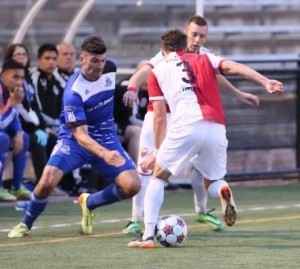
Frank Jonke in action for FCE against the Ottawa Fury. PHOTO: TONY LEWIS/FC EDMONTON
A month before the start of FC Edmonton’s training camp, Frank Jonke was awoken by a terrible pain in his gut. The Canadian striker was in agony. Not only was the pain severe, he couldn’t keep food down. By the time the NASL team’s camp opened, he was down 15 pounds.But, the pain went away as quickly as it came. And doctors never were able to diagnose what was wrong. A virus? Food poisoning? The only thing they were able to rule out was a food allergy.
Jonke missed the first couple of days of training camp.
Jonke sees the silver lining. “Now that I lost that weight, I am quicker and lighter,” he said. And he isn’t sure if he’s going to try and put that weight back on.
Maybe the change will be good for Jonke, because he desperately wants 2015 to be the year where he proves 2014 was a fluke. Jonke arrived in Edmonton in 2014, after playing for coach Colin Miller on the Canadian national team. Jonke decided to leave Finnish football behind for the NASL, and hopes were high that the forward nicknamed “Bully” would terrify opposition centre backs.
But, in 17 NASL games, Jonke didn’t score; that came in stark contrast to Canadian Championship games, where he was one of the Eddies’ most effective players. And, in the second leg of their Canadian Championship semifinal against the Montreal Impact, Jonke scored twice, including a penalty-kick conversion.
To add injury to the insult, Jonke spent much of the fall season on the sidelines, trying to regain focus after a concussion.
“Frank and I have spoken about what happened last season,” said Miller. “That’s the one thing about Frank, he’s very honest. I didn’t have to tell him how disappointing last season was. He knew it was.”
And, with the lost weight and the urge to make fans forget 2014, Miller feels the re-energized Jonke will almost be like a new signing for the club.
“Last year was so disappointing; I didn’t realize my goals as a player and as a teammate,” said Jonke. “It was tough. But you have to realize that not every day is going to be a sunny day. Now, I feel that I can only go up. There will be positives, because I have experienced all of the negatives.”
Jonke said that the concussion only compounded the frustration. He wanted so badly to get onto the pitch and redeem himself, but was forced to watch the games from the sidelines, as the Eddies made a late-season charge for a post-season slot.
Maybe it’s a show of confidence, but Miller didn’t do much to change the mix at striker. Jonke, Tomi Ameobi, Darul Fordyce and the young Sadi Jalali remain the options. Where Miller made additions was in the slot behind the strikers. Miller said Icelandic winger Oskar Orn Hauksson can be used on the wing or as a number 10. (He can also drop Fordyce back to use as the 10.) And former MLSer Sainey Nyassi adds speed either down the middle or on the wing.
Jonke is enthused by the changes.
“It’s going to be a tremendous help. That’s not to say we didn’t have good players last year. But each of the new players brings a new element to the team. That’s the coach’s job, to identify what’s missing and to fill those gaps. And I think that’s what’s been done.”
Now, Jonke just wants to bury those chances. He’s dropped 15 pounds — now he just has to take the weight of the world off his shoulders.
THIS IS A PREVIEW OF AN ARTICLE THAT WILL APPEAR IN PLASTIC PITCH 5, OUT LATER THIS MARCH! SUBSCRIBE TODAY! SEE IT ON APPLE and ANDROID DEVICES.
Or, visit the PLASTIC PITCH SHOPIFY STORE!
Canadian women don’t score much in Cyprus, but give up even less
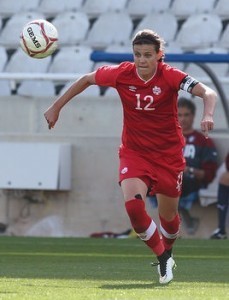
Christine Sinclair PHOTO: Ville Vuorinen
Before the Cyprus Cup kicked off, Canadian national women’s team coach John Herdman talked about how important it would be for his players to remain organized. He talked about how vital it was for the team to keep its shape.Throughout the tournament, he emphasized how it was key for his players to keep things tight.
So, maybe, just maybe, we shouldn’t fret too much about Canada losing the final to England by a 1-0 score on Wednesday. Lianne Sanderson’s goal came as both teams coped with driving rain. And, the goal was the only time in three group-stage games and the final that Canada conceded. One goal against in four matches — well, not an entirely terrible return.
If the emphasis of this tournament was on defence, we shouldn’t worry too much that Canada scored just four times in four games in its final major tournament ahead of the Women’s World Cup. Right? Wrong. Of course we’re going to worry. The slate of 1-0 and 2-0 results in the Cyprus Cup — which generally attracts what Herdman refers to as the “second-tier” teams while the major powers go to the Algarve Cup — is not going to give Canadian fans the confidence to believe we’ll be able to find a lot of goals outside of our top target striker, Christine Sinclair.
Maybe this is the plan — as Herdman said, there aren’t too many cards left up his sleeve. When we see Canada in June at the Women’s World Cup, this might be a team that will concern itself with keeping things clean in its own end and wait for the opponent to make a mistake or get caught pressing.
At least one May friendly awaits the team on Canadian soil. The date suggests the game will be against another World Cup qualifier, one who is already here as part of its preparations for the big tournament.
It would have been nice for Canada to lay down a marker by registering a few big wins in Cyprus. Instead, the tournament was a reminder of how the rest of the world continues to close the gap. While Canada shut out Scotland, South Korea and Italy, none of their wins were routs.
READ THE NEW ISSUE OF PLASTIC PITCH! CANADIAN SOCCER. CANADIAN STORIES. OUT NOW FOR APPLE and ANDROID DEVICES.
Or, visit the PLASTIC PITCH SHOPIFY STORE!
March 10, 2015
Canada’s U-17s fail to take advantage of chance to make up goal-difference gap
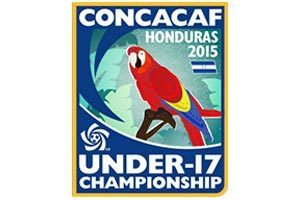 There’s an old sports adage that tells us that we shouldn’t criticize the wins.
There’s an old sports adage that tells us that we shouldn’t criticize the wins.
But, for Canada’s U-17 team, the 3-1 win over Saint Lucia Monday at the CONCACAF U-17 Championship in Honduras comes about as close as we can get to the win that you’re not 100 per cent happy about.
Canada went into the game tied on points atop the Group B standings with Mexico, but trailed El Tri by five on goal difference. To improve the odds of winning the group, Canada didn’t just need to beat Saint Lucia, but throttle the islanders. Daniel Sagno, Duwayne Ewart and Ballou Tabla scored for Canada in a game it expected to win by more than two.
“I think there was an intensity level we didn’t have and I don’t understand that,” Canadian coach Sean Fleming said after the game. “Any time you’re putting on the jersey for your country, there should be no question that you’re ready to play and it doesn’t matter the opponent. We respect Saint Lucia in our preparations and everything, and the players started being more individuals and that hurt us a little bit. We really have to go and look at things and get better if we’re going to move on in the tournament.”
What made the, ahem, result hurt even more was the fact that Mexico was only able to beat Haiti 2-0. The door was open for Canada to make up the goal difference.
Now, Canada and Mexico have just one last group-stage game left. The Mexicans play Costa Rica, while Canada plays Panama, who was just eliminated from contention.
The Costa Ricans can still win the group if they beat Mexico and Canada does not beat Panama, so it’s easy to see they’ll put their best feet forward. How Panama will react to its final game will be interesting to see. ??The winner of the group gets automatic passage to the U-17 World Cup. The second- and third-place finishers go into a four-team playoff pool with the second- and third-place finishers from Group A. The two winners of those playoff matches will qualify.
Canada is guaranteed at least a playoff spot.
READ THE NEW ISSUE OF PLASTIC PITCH! CANADIAN SOCCER. CANADIAN STORIES. OUT NOW FOR APPLE and ANDROID DEVICES.
Or, visit the PLASTIC PITCH SHOPIFY STORE!
March 9, 2015
Introducing our new quintessentially Canadian MLS power rankings
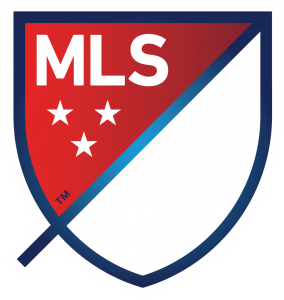 Long-time Canadian international Iain Hume had an interesting take on Saturday’s “Canadian” MLS season-opener at BC Place between the Whitecaps and Toronto FC.
Long-time Canadian international Iain Hume had an interesting take on Saturday’s “Canadian” MLS season-opener at BC Place between the Whitecaps and Toronto FC.
In a tweet delivered just as the game kicked off, Hume used the #farce hashtag to sum up his feelings about the game. With each team starting just one Canadian — Russell Teibert for the Whitecaps and Jonathan Osorio in TFC red — Hume wanted his followers to know he wasn’t happy.
But, looking at the rosters throughout MLS, you can’t help escape the feeling that Hume could tweet out #farce week after week. And, in the spring issue (#5) of Plastic Pitch, we’re going to take a cold, hard look at the leagues we share at the United States and how we’re treated. The issue, which will be out later in March, will ask the hard question: Does being in MLS or NASL or NWSL really benefit Canadian soccer?
And, in keeping with that theme, we’re going to launch a new sorta power-rankings system. Sure, most power rankings are just throwaway click-bait; the kinda of mind-numbing stuff we promise ourselves we’ll never have to write again each time we bang one out.
But this one is different. Throughout the year, we’re going to rank MLS teams (and NASL, too, once the season starts in April) on how many minutes they give to Canadians. We’re not going to wax poetic about U-23 teams or developmental sides; for Canadian soccer to move forward, we need to see players regularly moving from developmental squad to first team, not just more and more Bryce Aldersons (and, look for our interview with Alderson in issue 5 of Plastic Pitch). We also don’t really care that some teams might have a Canadian warming the bench. To benefit our national program, we need our players getting first-team minutes.
So, let’s look at the rankings after week 1 of MLS action. The number on the right is the total number of minutes played by Canadians this season. So far, no MLS team has played more than one Canadian per game.
FC Dallas 90
Philadelphia Union 90
Toronto FC 90
Vancouver Whitecaps 64
All other teams tied at 0
Important notes: Ethan Finlay did play 90 minutes for Columbus; but, despite interest from our national side, he has not indicated that he will play for Canada. If this changes, the minutes played ranking will be changed to reflect that.
Tesho Akindele has gone to a U.S. camp, but the Calgary-born forward has said he hasn’t ruled out Canada. Since there are still overtures being made, he is counted, for now. But, again, the minutes will be adjusted if Akindele commits to the U.S. program. I’ve also counted Steven Vitoria, who was born in Toronto but represented Portugal as a youth. But there have still been overtures about him playing for Canada.
PLAYER RANKINGS:
T1. Tesho Akindele 90
T1. Jonathan Osorio 90
T1. Steven Vitoria 90
4. Russell Teibert 64
SPECIAL MENTION: This has to go to the Montreal Impact, which has now gone through two CONCACAF Champions League legs and one MLS match in 2015 without giving one solitary minute of action to a Canadian. Patrice Bernier has been on the bench, but hasn’t seen action. Well done to the Impact.
RANKING: Wow, just four Canadians saw action this week (and only two — Teibert and Osorio — who are right now in the national-team picture). And, with Canadian teams, we’re already averaging less than one Canadian starting per roster (two Canadians saw action out of the three teams). I don’t know if you can grade a league worse than an F. But, heck, F stands for #farce. Maybe Iain Hume was onto something.
READ THE NEW ISSUE OF PLASTIC PITCH! CANADIAN SOCCER. CANADIAN STORIES. OUT NOW FOR APPLE and ANDROID DEVICES.
Or, visit the PLASTIC PITCH SHOPIFY STORE!
March 7, 2015
What Canada has left: How it can qualify for U-17 World Cup
 So, after Friday’s encouraging (and maybe just a bit surprising) 1-1 draw with Mexico, Canada is sorta tied with El Tri at the top of the six-team Group B table at the CONCACAF U-17 Championship. Both team have two wins and one draw.
So, after Friday’s encouraging (and maybe just a bit surprising) 1-1 draw with Mexico, Canada is sorta tied with El Tri at the top of the six-team Group B table at the CONCACAF U-17 Championship. Both team have two wins and one draw.
But Mexico’s goal difference is +8, the Canadians are just three goals to the good.
To recap: Under the new format, the top team in the group gets an automatic entry into the U-17 World Cup. The second- and third-place finishers will play win-and-in playoff matches that also include the second- and third-place teams from Group A (but, under the new rules, they don’t necessarily cross over; the four teams would be ranked based on the points they got in the group stage; then it’s 1 vs. 4 and 2 vs. 3).
Costa Rica and Panama have six points each, while Mexico and Canada each have seven. But the Costa Ricans and Panamanians have to play each other, so we know that one or the other (or both, if they draw) won’t get maximum points out of their remaining two matches.
So Canada knows this: Win one of its remaining two games, and it will be guaranteed a top-three spot and, at worst, a playoff game. (That’s because Canada already beat Costa Rica and wins any potential tiebreaker with the Ticos). But, there is still the chance to actually win the group, but goal difference is the issue.
Canada plays St. Lucia in its next game; meanwhile, the Mexicans get Haiti. The two Caribbean minnows will be expected to be the receivers of what could be goal-difference-padding matches. But, truly, it’s not realistic for Canada to make up five goals.
The final matches will see Canada play Panama while the Mexicans face Costa Rica. And how those games play out may depend on what happens in the Panama-Costa Rica match.
So, now that we’ve walked through the scenarios, let’s book ourselves a chat with Stephen Hawking. We’re ready.
READ THE NEW ISSUE OF PLASTIC PITCH! CANADIAN SOCCER. CANADIAN STORIES. OUT NOW FOR APPLE and ANDROID DEVICES.
Or, visit the PLASTIC PITCH SHOPIFY STORE!
March 4, 2015
Free agency lite: A small step forward in new Major League Soccer CBA
 The players went into the Collective Bargaining Agreement process looking for some form of free agency. Major League Soccer and its owners said that free agency would never happen in their single entity system.
The players went into the Collective Bargaining Agreement process looking for some form of free agency. Major League Soccer and its owners said that free agency would never happen in their single entity system.
The compromise that was reached on Wednesday will ensure that no labour stoppage will delay the 2015 MLS season. But it’s hard to judge just what this new agreement in principle will do to the North American player market. According to reports, free agency will be granted to players who have eight years of service in the league, and are 28 years of age or older. But, the salary increases these “free agents” can earn for themselves will be capped.
So, in terms of owners opening the door on free agency, it’s barely open a crack. The lock is off, though — and it will be up to the players to kick it down when this CBA expires five years from now.
1) If you go into free agency, and the raise you can potentially earn for yourself is capped — well, that’s not really free agency, is it? It’s a reasonable facsimile of free agency. The league already has a salary cap — which would prevent GMs from overspending on the free agent market; capping the potential increases only adds another barrier for the player.
2) For a soccer player, 28 is old. A soccer player is on a much faster curve to develop than a football, basketball, baseball or hockey player. In hockey, the prime of a player’s career comes in the late 20s, early 30s. Baseball is also in the early 30s. Soccer players are at their best in their mid 20s. By age 28, they are already finding that they are on their downward slopes. A player looks at his career this way; he’s willing to take less as a youngster so he can establish himself. In the prime of his career, he needs to be earning the maximum he can get; and then he understands his salary will slowly wane as he gets older. But, at 28, the free agency (the earning years) period is out of sync with the prime of his career. So, this begs the question: In single entity, when the first 28-year-old goes on the open market, how many offers will he get? Or will this version of the free agency be much like MLS’s waiver draft, where the most common thing we see is players who want new deals being passed over?
3) Add to that the eight years of service, and a player knows this: If he wants to dedicate his career to playing in MLS, he needs to be playing in the league by age 20. This is like taking a crowbar to the knees of the NCAA teams; players know that if they come out of school and into the draft at 21 or 22, they’ll never get to free agency — at least until the next CBA might change things. So, if you’re a current MLS player between 21-23 years of age, you hope that the next CBA will open up free agency a little more.
4) With MLS teams having the ability to assign young players to USL affiliates, a move “down” to the affiliated club would have an effect on getting to those eight years of service. If I was on the MLSPU, I would have demanded this: That USL time served count the same as MLS time served. Think about how it works in pro hockey; any player who has more than three seasons of pro experience, but hasn’t played 80 NHL games, can be an unrestricted free agent at age 25. That means you can’t be stuck as a career minor leaguer without the chance to move on. Likewise, USL players who aren’t called up to their parent MLS clubs should have the chance to look for new clubs after a certain number of years/games served in the third division.
Still, despite serious reservations about how much 28/8 will actually change the marketplace (and, if you’re a regular reader of mine and haven’t figured out that I’m a champion of the free market, maybe I need a crowbar to make it more obvious), there is no doubt that the Pandora’s Box that is free agency has been opened. There is no way for MLS to shut it. The people who may want to invest in MLS expansion franchises know that the only way forward is to liberalize the free-agency process with CBA after CBA.
MLS grew up a little today; just a little. Free-agency-lite is a start.
READ THE NEW ISSUE OF PLASTIC PITCH! CANADIAN SOCCER. CANADIAN STORIES. OUT NOW FOR APPLE and ANDROID DEVICES.
Or, visit the PLASTIC PITCH SHOPIFY STORE!
Atlanta, Georgia, Canada: Porter joins the Silverbacks
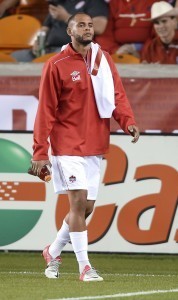
Kyle Porter
Kyle Porter has returned to the NASL.The Atlanta Silverbacks announced Wednesday that they have signed the Canadian international. Porter will be reunited with fellow Canadian former FC Edmonton teammate Dominic Oppong, who signed with the Silverbacks last month.
Porter spent the previous two seasons with the DC United organization, but spent much of 2014 with the MLS team’s USL affiliate in Richmond. He was released at the end of the season.
Before that, he spent two seasons with FC Edmonton, scoring a total of 12 goals; the Eddies offered him a new contract, but he chose to pursue a what turned into a successful trial with DC United and the Eddies pulled the offer off the table.
“In all honesty, I think Kyle is one of the most exciting additions that we’ve added to the group this offseason,” said Silverbacks coach Gary Smith in a release issued by the club. “He’s quick, he’s powerful and he is a very talented player. Individually, he’s capable of producing excellence on the ball in 1-versus-1 situations and he has an extraordinary eye for goal at this level.”
READ THE NEW ISSUE OF PLASTIC PITCH! CANADIAN SOCCER. CANADIAN STORIES. OUT NOW FOR APPLE and ANDROID DEVICES.
Or, visit the PLASTIC PITCH SHOPIFY STORE!



